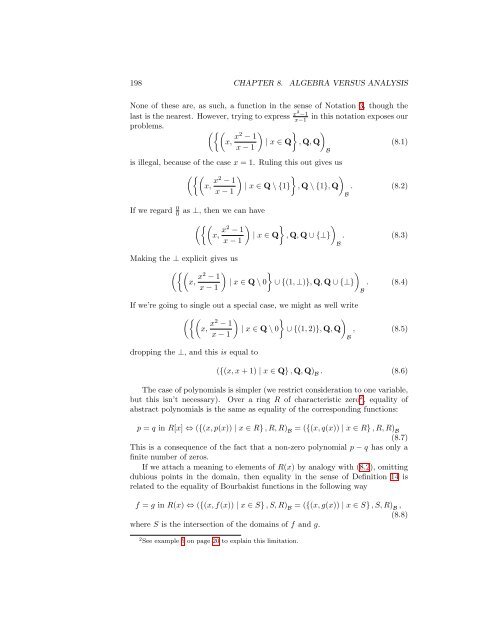Contents - Student subdomain for University of Bath
Contents - Student subdomain for University of Bath
Contents - Student subdomain for University of Bath
Create successful ePaper yourself
Turn your PDF publications into a flip-book with our unique Google optimized e-Paper software.
198 CHAPTER 8. ALGEBRA VERSUS ANALYSIS<br />
None <strong>of</strong> these are, as such, a function in the sense <strong>of</strong> Notation 3, though the<br />
last is the nearest. However, trying to express x2 −1<br />
x−1<br />
in this notation exposes our<br />
problems.<br />
({( ) } )<br />
x, x2 − 1<br />
| x ∈ Q , Q, Q<br />
(8.1)<br />
x − 1<br />
B<br />
is illegal, because <strong>of</strong> the case x = 1. Ruling this out gives us<br />
({( )<br />
}<br />
)<br />
x, x2 − 1<br />
| x ∈ Q \ {1} , Q \ {1}, Q . (8.2)<br />
x − 1<br />
B<br />
If we regard 0 0<br />
as ⊥, then we can have<br />
({( ) }<br />
)<br />
x, x2 − 1<br />
| x ∈ Q , Q, Q ∪ {⊥} . (8.3)<br />
x − 1<br />
B<br />
Making the ⊥ explicit gives us<br />
({( ) }<br />
)<br />
x, x2 − 1<br />
| x ∈ Q \ 0 ∪ {(1, ⊥)}, Q, Q ∪ {⊥} . (8.4)<br />
x − 1<br />
B<br />
If we’re going to single out a special case, we might as well write<br />
({( ) }<br />
)<br />
x, x2 − 1<br />
| x ∈ Q \ 0 ∪ {(1, 2)}, Q, Q , (8.5)<br />
x − 1<br />
B<br />
dropping the ⊥, and this is equal to<br />
({(x, x + 1) | x ∈ Q} , Q, Q) B<br />
. (8.6)<br />
The case <strong>of</strong> polynomials is simpler (we restrict consideration to one variable,<br />
but this isn’t necessary). Over a ring R <strong>of</strong> characteristic zero 2 , equality <strong>of</strong><br />
abstract polynomials is the same as equality <strong>of</strong> the corresponding functions:<br />
p = q in R[x] ⇔ ({(x, p(x)) | x ∈ R} , R, R) B<br />
= ({(x, q(x)) | x ∈ R} , R, R) B<br />
(8.7)<br />
This is a consequence <strong>of</strong> the fact that a non-zero polynomial p − q has only a<br />
finite number <strong>of</strong> zeros.<br />
If we attach a meaning to elements <strong>of</strong> R(x) by analogy with (8.2), omitting<br />
dubious points in the domain, then equality in the sense <strong>of</strong> Definition 14 is<br />
related to the equality <strong>of</strong> Bourbakist functions in the following way<br />
f = g in R(x) ⇔ ({(x, f(x)) | x ∈ S} , S, R) B<br />
= ({(x, g(x)) | x ∈ S} , S, R) B<br />
,<br />
(8.8)<br />
where S is the intersection <strong>of</strong> the domains <strong>of</strong> f and g.<br />
2 See example 5 on page 20 to explain this limitation.












![[Luyben] Process Mod.. - Student subdomain for University of Bath](https://img.yumpu.com/26471077/1/171x260/luyben-process-mod-student-subdomain-for-university-of-bath.jpg?quality=85)



